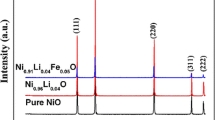New moisture-sensitive ceramic materials in the Li2MoO4-Li2WO4 system were obtained. Use of these materials as humidity sensors demonstrated their promise for use in systems for controlling the moisture content of gaseous industrial media and ambient air, for example, in construction, due to the miniature nature, fast response, high sensitivity, and wide range of working temperatures and measurable relative humidity.
Similar content being viewed by others
References
G. N. Maslennikova, R. A. Mamaladze, S. Midzuta, and K. Koumoto, Ceramic Materials [in Russian], Stroiizdat, Moscow (1991).
Le Hoang Mai, Pham Thi Mai Hoa, Nguyen Tien Binh, et al., “Some investigation results of the instability of humidity sensors based on alumina and porous silicon materials,” Sensors Actuators B, 66, 63–65 (2000).
E. Traversa, M. Baroncini, E. Di Bartolomeo, et al., “Electrical humidity response of sol-gel processed undoped and alkalidoped TiO2-Al2O3 thin films,” J. Eur. Ceram. Soc., 19, 753–758 (1999).
R. S. Niranjan, S. D. Sathaye, and I. S. Mulla, “Bilayered tin oxide: zirconia thin film as a humidity sensor,” Sensors Actuators B, 81, 64–67 (2001).
W. Qu, W. Wlodarski, and J.-U. Meyer, “Comparative study on micromorphology and humidity sensitive properties of thin-film and thick-film humidity sensors based on semiconducting MnWO4,” Sensors Actuators B, 64, 76–82 (2000).
J. Shah, R. K. Kotnala, B. Singh, and H. Kishan, “Microstructure-dependent humidity sensitivity of porous MgFe2O4-CeO2 ceramic,” Sensors Actuators B, 128, No. 1, 306–311 (2000).
M. Viviani, M. T. Buscaglia, V. Buscaglia, et al., “Barium perovskites as humidity sensing materials,” J. Eur. Ceram. Soc., 21, 1981–1984 (2001).
A. I. Buturlin, S. A. Krugovertsev, and Yu. D. Chistyakov, “Monitoring humidity in integrated microcircuit casings,” Zarubezh. Elektron. Tekhn., No. 2, 3–63 (1987).
B. F. Ormond, Structures of Inorganic Substances [in Russian], Moscow-Leningrad (1950).
E. I. Get'man, Isomorphic Substitution in Tungstate and Molybdate Systems [in Russian], Novosibirsk (1985).
T. Nagasaki, S. Inui, and T. Matsui, “Phase relation in Li2MoO4-Li2WO4 system,” Thermochim. Acta, 352–353, 81–85 (2000).
O. P. Barinova, S. A. Pershikov, S. V. Kirsanova, and V. E. Zhbanko, “Use of an automated heat-carrier humidity control system in drying ceramics,” in: Proceedings of the XVII International Conference “MKKhT-2003” [in Russian], Moscow (2003), pp. 16–22.
Author information
Authors and Affiliations
Additional information
Translated from Steklo i Keramika, No. 10, pp. 40–43, October, 2008.
Rights and permissions
About this article
Cite this article
Barinova, O.P., Kirsanova, S.V. Moisture-sensitive ceramics of the Li2MoO4-Li2WO4 system. Glass Ceram 65, 362–365 (2008). https://doi.org/10.1007/s10717-009-9080-3
Published:
Issue Date:
DOI: https://doi.org/10.1007/s10717-009-9080-3




